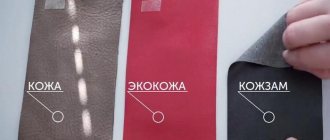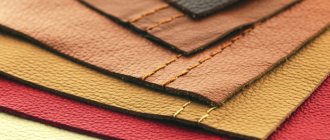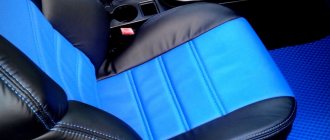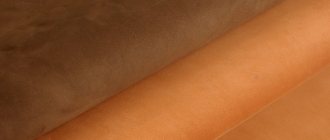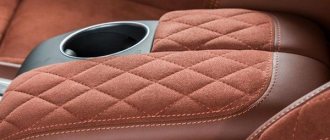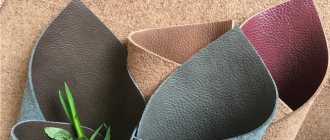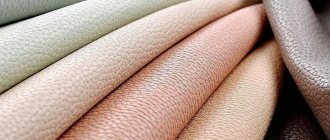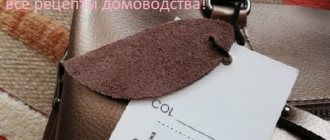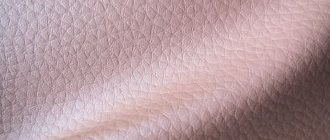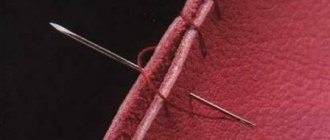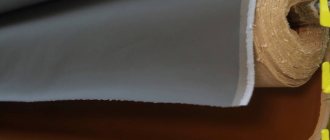Saffiano leather products are the subject of heated debate. All thanks to the ambiguous type of material and the confusing history of origin. Morocco has been known since ancient times.
Morocco boots are mentioned in Russian epics and chronicles of the 10th century, where they are contrasted with bast shoes as a sign of belonging to the aristocracy. Shoes were made from goatskin, which was distinguished by its softness, pleasant velvety texture and bright color (most often red). Modern Saffiano has little in common with ancient morocco. A distinctive feature of the material is its specific fine embossing.
Description of saffiano leather
Saffiano leather, common these days, has Italian roots. The patent for "Saffiano" belongs to the world famous brand "Prada". Back in 1913, the company released a handbag with a specific branded embossing. Photo:
The interesting texture added originality and practicality to the bags. The morocco surface does not scratch or wear off. Leather products can last 10 years or more, maintaining an excellent appearance. Even then the material was appreciated. Bags, wallets, and other leather goods were made from it.
But the real “morocco boom” came in 2012, when global brands unanimously released a series of accessories with characteristic embossing. Love Moschino, DKNY, Michael Kors handbags immediately found a response in women's hearts. They were dreamed about, wanted, and bought en masse by women of all ages.
Saffiano leather – natural material or not?
Initially, saffiano is genuine leather. According to the definition:
Saffiano leather is a textured calfskin that is resistant to stains and scratches.
It is thanks to its texture with diagonal fine embossing that the material acquires high strength and resistance to abrasion and scratches. On the other hand, such a finish makes it look like leatherette. The rough surface is not as pleasant to the touch, and, according to some people, it looks “cheap”.
Please note that natural saffiano leather is often counterfeited. An explosion of popularity in 2012 gave rise to the production of materials with a similar texture. In this regard, many began to distinguish the morocco effect:
If the material simply says “Saffiano”, it means it has been hot stamped (a “ribbed” or other pattern has been applied).
By the way, similar embossing can be seen on the covers and bindings of books. This is not genuine leather, but a polyvinyl or polyamide substitute (lederin or other).
Caring for pressed leather products
Proper care can extend the life of your favorite item . Dirt is removed with a damp sponge; if necessary, you can use a washing solution (for example, detergent for delicate fabrics). Excess product is removed with an absorbent cloth and then wiped dry with a microfiber cloth.
Removing grease stains causes big problems . You will have to use special stain removers. Pressed leather items should not be soaked or washed. This can cause them to lose their shape and become permanently deformed. If you need to clean the lining, you will have to tear it off and wash it separately. If the item needs to be dried, then it is straightened out and left hanging at room temperature until completely dry.
After cleaning, belts and bags can be treated with a sponge with a silicone mixture . This will give the item a well-groomed appearance and disguise minor defects. After this treatment, the surface will become less dirty and attract dust.
Compound
Saffiano leather is made mainly from calf skins, less often sheep skins.
Cattle calf leather is considered the highest quality and most valuable. It is soft, does not crack at low temperatures, does not break at bends, does not wear out for a long time, and can withstand heavy loads perfectly. Sheep leather is slightly inferior to calfskin in strength. Otherwise, it is of the same quality and is widely used for the production of expensive bags and wallets.
Saffiano is made as follows:
- Animal skins are soaked and cleaned of dirt.
- They perform liming and sodding - removing hairs and trimming wool.
- The subcutaneous fat layer (flesh) is removed.
- The raw materials are deashed and washed thoroughly.
- Next comes tanning.
- The finished semi-finished product is leveled in thickness, folds are smoothed out, and painted.
- Morocco embossing is performed on a special machine at a temperature of 160-170 degrees.
- Finally, the front surface is covered with finishing waxes.
To reduce the cost of saffiano leather products, skins with defects can be used. Hot stamping allows you to hide them. Substitutes with the “morocco” effect contain polyurethane.
How to distinguish genuine leather from pressed leather
In order to determine what kind of leather an item is made of, you can use the piece of material included with the product. If it looks like stretched skin, then the material is natural. For analogues, the label is made in the form of a diamond.
It is necessary to inspect and feel the product itself. The following points indicate genuine leather:
- Elasticity (skin stretches and returns to its original state):
- If you smell the product, there is no synthetic smell.
- If you squeeze the skin with your fingers or bend it, it then quickly straightens out, leaving no folds or creases on the surface.
- Genuine leather, squeezed in the hands, gradually heats up, while artificial material does not change its temperature.
- The color of natural material is not uniform, the pores have different depths and shapes.
- The edges are slightly tucked inward or rolled up, while the pressed one is smooth and even; sometimes threads may stick out.
- Under the influence of a flame, the skin will begin to smolder, and the artificial analogue will burn to ash.
- Pressed leather has a smooth backside (although some unscrupulous manufacturers may stick on suede).
- When exposed to water, the natural material becomes wet and darkens.
Most often, pressed leather is indicated by the low cost of the product . During wear, things quickly lose their shape, become covered with a network of wrinkles, and can burst at the folds.
Characteristic
The material has a lot of positive properties. But above all, it is valued for its wear resistance. Characteristics of Saffiano leather:
- durable;
- dense;
- resistant to cuts, scratches, abrasion;
- has little elasticity;
- holds its shape well;
- resistant to moisture and dirt.
The material has few disadvantages, and they are all mostly subjective:
- Morocco wood does not allow air to pass through well. High density and embossing impair air circulation. Shoes and clothes may not be too comfortable and stuffy. Combining with natural suede, leather and fabric saves the situation. But it is worth noting that shoes, boots and jackets made of morocco are rare. Leather is primarily used for the production of leather goods.
- Saffiano leather does not look like genuine leather. This is true. Embossing completely erases the “face” of the skin – the pattern is diminished. The finishing also destroys the characteristic leather smell. Nevertheless, many people find morocco very attractive and original.
The material has one significant disadvantage - natural saffiano leather can easily be confused with a polyurethane substitute for saffiano leather.
Description and production
what does pressed leather look like?
What artificial leather is made from: pieces, dust, trimmings - any remnants of natural material.
Interesting
In addition to primary raw materials, secondary ones are used. That is, the remains of the skin from the press are also used.
How to make pressed leather:
- The remains of natural materials are crushed using a special device.
- The composition is removed from excess impurities and debris. Remove all components not related to the skin.
- They are connected to each other under strong pressure from a leather press. To make the connection happen, polyester, polyamide, and polyethylene fibers are added.
- The resulting piece of flat material is dried in a special oven.
- At high temperatures, synthetics melt and bind together natural tanning waste. In addition to fibers, polyester resins are added. They promote reliable adhesion of skin particles. Synthetic substances impregnate the fabric for better adhesion.
- It is cooled and the resulting leather is pressed, ready for finishing.
- The fabric is dyed and designs are applied. They change the texture, structure, relief. Add embossing.
Synthetic leather cannot withstand cold or extreme heat. In the summer, under the sun, at high temperatures, it will begin to melt and lose its shape. In winter, such products crack and become covered with wrinkles. The thing will burst at the bend in two or three months. The canvas does not hold its original shape for long. It does not allow air or moisture to pass through; a person will quickly sweat in such clothes and shoes.
The material also has advantages:
- inexpensive;
- externally similar to natural, indistinguishable at first glance;
- Suitable for making many items;
- beautiful designer things are created from it.
When choosing the right product, recycled matter will bring only positive emotions.
Morocco bags – what are they?
Michael Kors has been actively using saffiano leather in its collections for many years. The brand, in a sense, became associated with morocco. Casual, formal office bags, wallets, clutches, crossbodies - you can choose a model to suit every taste.
You can see saffiano leather on bags from such famous fashion houses as Prada, Furla, Cerruti, Celine, Burberry, Salvatore Ferragamo, Gucci, Dolce & Gabbana, Cerruti, Paul Smith. As a rule, they produce the same bag model from different materials.
It's not just luxury brands that use embossed leather. Bags and accessories made from it are found in the collections of relatively modest companies Fabi, Baldinini, Le Tanneur, Longchamp, Enquer, Brooks Brothers, Montblanc and others. Saffiano leather backpacks and belts are also produced. Sometimes it is combined with other materials.
Reviews
Saffiano leather products are not for everyone. This conclusion can be drawn from mixed reviews on the Internet:
Victoria M.:
“When I first bought a Michael Kors saffiano leather bag, I had no idea that it was a great investment. I spent 10 thousand rubles. As a result, 5 years have passed, and the bag is like new. True, I have two other bags for my shift. But even if you only wear it day after day, it seems to me that the condition will not change. I don’t know how they achieve such quality, but it really justifies the high price.”
Natalya Klimenko:
“A very good bag, I would say indestructible. It doesn't rub and washes well. Regarding whether the leather is genuine or not, a person working at a leather factory said that now the fake is of such high quality that an ordinary person would not be able to tell the difference in life.”
Amina:
“The quality is good, yes. But I still don't really like my Saffiano leather Donna Karan. It reminds me too much of polyurethane.”
Larisa:
“I recently received a Michael Kors bag and was really disappointed. I always really like the smell of leather. And this morocco smells nothing at all. As I understand it, this is due to special processing. So you can see that the leather is natural, good quality. I liked that it holds its shape well. You can wear it. But it didn’t create a “wow” effect.”
How to check leather for naturalness by appearance
Often, unscrupulous manufacturers try to pass off a pressed product as natural, increasing its cost. It is extremely difficult to distinguish between these materials, especially if you don’t know what to look for.
Quality of stitching and internal seams
To determine the type of material, you must first pay attention to the quality of the stitching and internal seams. If they have signs of adhesion, then the product is pressed. In addition, when processing natural fabric, in most cases a hem is made. The seams in this case are thicker. When processing artificial fabric, they become thinner.
Material thickness and edge
Thickness is not always indicative when determining the type of product. This parameter depends on the quality of the finish. In this case, inspection of the edge reveals the structure. In natural products it is represented by a large number of suede fibers. On a cut of artificial fabric you can see the threads.
Elasticity and color when pressed or bent
Another parameter that you need to pay attention to is color and elasticity when bending and pressing. If the material is natural, such manipulations do not change color. It is characterized by increased elasticity. The structure of the canvas does not change. Natural material that has been bent quickly regains its shape. Pressed leather has low elasticity, so defects remain on it for a long time.
Relief and pores of the material
Cured leather always has an uneven texture. The pores are directed in one direction. They are similar, but they cannot be identical. Synthetic leather has a repeating texture.
Back: fiber or fabric
To determine the quality of the material, it is advisable to examine the reverse side. Products made by pressing, in most cases, have a fabric base. The reverse side of the natural material resembles loose suede. At the same time, some unscrupulous manufacturers glue artificial suede to the reverse side. In this case, only examination of the section allows us to determine the type of product.
What about morocco boots?
Many people know about morocco boots from old films and books. They were worn by “good fellows,” merchants, princes and the entire wealthy class. The boots looked bright red, multi-colored, embroidered with gold, often lined with iron shoes, with an upturned toe. Women's boots were called morocco boots. For commoners they were a luxury.
For sewing boots, specially tanned leather was used - morocco ("sofyan" is an erroneous spelling). According to the definition:
Saffiano is an ancient type of leather, vegetable-tanned from goat skins and dyed a bright color. Currently not in production.
According to one version, morocco was named after the Moroccan city of Safi. The national footwear of Morocco, babouches (shoes without backs), was made primarily from embossed morocco. One way or another, the material was brought to Russia from other countries. Later, in 1666, its own production was opened. The technology was incredibly complex:
- Goat skins were soaked in water and then in ash pans.
- After the hair began to separate, it was collected on a block.
- The skins were returned back to the ash pit for 1-2 weeks to produce fat.
- The raw materials were flayed, and the front side was carefully shaved and made smooth with a stone.
- At the next stage, the canvases were washed under running water in special rotating barrels.
- For a flawless “face,” the skin was placed in wheat jelly, washed and passed through several vats of sumac juice.
- Then the sumac plant was tanned.
- After tanning, morocco was dyed in bright colors. Natural dyes were used - plant or animal (for example, cochineal mealybug). To ensure color stability, the leather was etched with a warm solution of stannous chloride or alumina mordant.
- Finally, the painted and dried leather was given a gloss finish. The surface was smeared with a mixture of dye, beaten egg whites, linseed oil and passed with force through a glass cylinder.
Sometimes a pattern was rolled onto the skin with a roller. Morocco boots were considered the best shoes and cost fabulous money.
Less commonly, furniture was covered with morocco and book bindings were made from it.
Mention of the material in the literature:
- “I put on morocco boots with carved designs of all sorts of colors.” Gogol, “Dead Souls”.
- “Like girls, in an elegant headdress of yellow, blue and pink haircuts, on top of which a gold braid was tied, in thin shirts embroidered along the entire seam with red silk and studded with small silver flowers, in morocco boots on high iron horseshoes, smoothly, like peahens, and with a noise like a whirlwind, they galloped in the turtle dove.” Gogol, Evenings on a Farm near Dikanka.
- “The red wide morocco sofa obviously served as Rogozhin’s bed.” Dostoevsky, "The Idiot".
- “These soft-bound books made of delicate green morocco are still with me.” Kuprin, “Sentimental Novel”.
Today, morocco products can only be seen in museums and ethnic exhibitions. They are part of history.
Questions and answers
Question: How to properly care for the material?
Answer: Saffiano leather does not require lubrication. Caring for it comes down to wiping with a damp cloth. It is recommended to use a microfiber cloth, which best absorbs dust and dirt. If your bag suddenly gets wet from rain, you can dry it away from heat sources in a dry, ventilated area. If after drying it becomes rough, a special moisturizing balm will help save the situation.
Question: How to distinguish natural saffiano leather from artificial leather?
Answer: First of all, products made from natural raw materials are expensive, have high-quality fittings, neat seams, tags with an article number (serial number) and a QR code inside. You can distinguish saffiano leather from a substitute by checking it with the original embossing pattern and by touch. Natural material is softer. Although it is dense, it is elastic. The leatherette is “oak” and has a stronger shine.
Saffiano leather today refers to embossed saffiano leather. Often, products from a substitute are produced with similar embossing. In both cases, it is a strong, wear-resistant material that requires minimal maintenance. It is important not to confuse saffiano with antique morocco, a brightly colored soft goatskin. They have one thing in common - a similar name.
How is artificial leather made?
The basis is taken from natural materials : scraps, substandard residues, leather dust and shavings. Everything is crushed, the mixture is cleared of debris and impurities. Synthetic materials are added to bind the components into a homogeneous mass. Typically these are polyethylene, polyamides and polyesters. The mixture is pressed under high pressure until it forms a solid piece and then dried in an oven. After cooling, a leather-like fabric . It is painted, variously embossed or varnished. The result is a material that occupies an intermediate position between natural and artificial leather.
